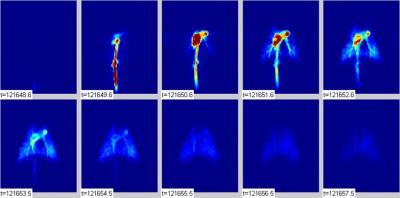Researchers at the University of Pennsylvania School of Medicine are harnessing two new, non-invasive techniques to look more closely inside the working lungs - leading to early detection of diseases, like emphysema, before it becomes evident in other modes of imaging.
"Up until now, imaging the way lungs function in real time has been limited by conventional methods which result in rather low resolution images," comments Warren Gefter, MD, Chief of Thoracic Imaging in the Radiology Department at Penn. "We are developing a way to get a better look inside the lungs by polarizing atoms -- making them all spin in the same direction -- with magnetic resonance [MR], which allows the atoms to have a strong signal for sharper images." This series of pictures, taken by Penn imaging researchers, show an animal lung captured with the new hyperpolarized MRI technique now being studied. A liquid solution containing Carbon-13 was injected into the bloodstream. The MRI picks up the signal as the Carbon-13 moves moves through the lung. Looking at these images provides information about localized blood flow in the lungs. Credit: Courtesy: University of Pennsylvania School of Medicine
This series of pictures, taken by Penn imaging researchers, show an animal lung captured with the new hyperpolarized MRI technique now being studied. A liquid solution containing Carbon-13 was injected into the bloodstream. The MRI picks up the signal as the Carbon-13 moves moves through the lung. Looking at these images provides information about localized blood flow in the lungs. Credit: Courtesy: University of Pennsylvania School of Medicine
Hyperpolarized 3He gas allows radiologists to observe the lung as gas flows in and out, giving them high resolution images of human ventilation. Combining several techniques enables researchers to measure the rate of diffusion of these helium gas molecules, which reflect the size of the air sacs in the lung. This, in turn, allows researchers to detect very early emphysema, even before it's evident on CT (computed tomography) - providing physicians with additional information in which to make diagnoses and offer treatment.
Gefter adds, "We have moved from imaging the structure to imaging the function of the lung to a scale well below a millimeter in size. It's truly groundbreaking."
To use this extremely powerful research tool, which provides accurate and precise measurements, patients must inhale the helium at the exact right time, after it's been exposed to a laser light to make all of the atoms spin in the same direction, creating the polarized helium, which then enters the lung.
Utilizing another new MR technique, Penn imaging researchers are pushing the scale of what we see in the lung down to an even smaller level -- to the cellular and intracellular level. Investigators have figured out a way in which they hope to look for a "marker" of disease inside the body. In animal models, they are injecting polarized carbon-13-labeled molecules and watching its conversion in real time. They can take images of the carbon-13 as it shuffles through the metabolic steps inside the cell.
Rahim Rizi, PhD, Associate Professor of Radiology at Penn, explains, "We observe the polarized carbon-13 labeled molecule as it breaks down and releases energy. What this 'flagged molecule' converts into could tell us whether the cell is normal or abnormal. This is a whole new approach to molecular imaging. For the first time, we can now follow the C-13 molecule, in real time, as it moves throughout the body to pinpoint the location of disease. It's real-time molecular imaging. This is revolutionary to MRI technology."
Penn is one of only a few sites in the world, and the only site on the East Coast, with this capability. Penn researchers hope to translate this technique for use in humans before the end of 2007.
Written from a news release by University of Pennsylvania School of Medicine.